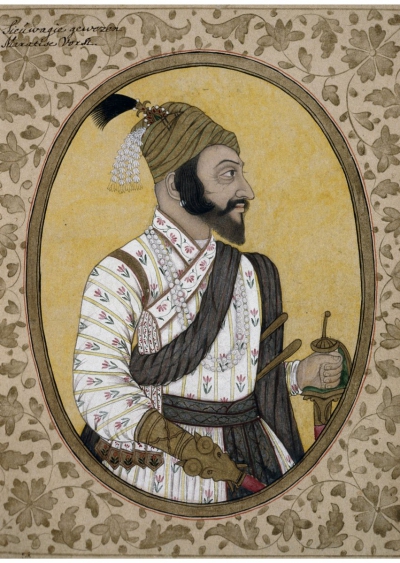The Maratha Empire, later known as the Maratha Confederacy, was a confederacy that came to dominate a large portion of early modern India in the 18th century. Maratha rule formally began in 1674 with the coronation of Shivaji as the Chhatrapati (Marathi: "Keeper of the Umbrella"). Maratha rule officially ended in 1818 with the defeat of Peshwa Bajirao II at the hands of the English East India Company. The Marathas are responsible for the end of the Mughal Empire over most of the Indian subcontinent.The Marathas were a Marathi-speaking warrior group from the western Deccan Plateau (present-day Maharashtra) who rose to prominence by establishing Hindavi Swarajya (meaning "self-rule of Hindus"). The Marathas became prominent in the 17th century under the leadership of Shivaji, who revolted against the Adil Shahi dynasty, and the Mughals to carve out a kingdom with Raigad as his capital. His father, Shahaji had earlier conquered Thanjavur which Shivaji's half-brother, Venkoji Rao (alias Ekoji) inherited. This kingdom was known as the Thanjavur Maratha kingdom. Bangalore which was established in 1537 by a vassal of the Vijayanagara Empire, Kempe Gowda I who declared independence, was captured in 1638 by a large Adil Shahi Bijapur army led by Ranadulla Khan who, accompanied by his second in command Shahaji, defeated Kempe Gowda III. As a result, Bangalore was given to Shahaji as a jagir (feudal estate). Known for their mobility, the Marathas were able to consolidate their territory during the MughalMaratha Wars and later controlled a large part of the Indian subcontinent.
Upon his release from Mughal captivity, Shahu became the Maratha ruler after a brief struggle with his aunt Tarabai, with the help of Balaji Vishwanath. Pleased by his help, Shahu appointed Balaji and later, his descendants, as the Peshwas or prime ministers of the empire. Balaji and his descendants played a key role in the expansion of Maratha rule. The empire at its peak stretched from Tamil Nadu in the south, to Peshawar (modern-day Khyber Pakhtunkhwa, Pakistan) in the north, and Orissa & West Bengal up to the Hooghly River, in the east. The Marathas discussed abolishing the Mughal throne and placing Vishwas Rao on it in Delhi. In 1761, the Maratha Army lost the Third Battle of Panipat, which halted their imperial expansion into Afghanistan. Ten years after Panipat, the young Peshwa Madhav Rao I's Maratha Resurrection reinstated Maratha authority over North India.
In a bid to effectively manage the large empire, Madhav Rao gave semi-autonomy to the strongest of the knights, and created a confederacy of Maratha states. These leaders became known as the Gaekwads of Baroda, the Holkars of Indore and Malwa, the Scindias of Gwalior and Ujjain, the Bhonsales of Nagpur, the Jadhavs of Vidarbha, the Dabhades of Gujarat, the Puars of Dhar and Dewas. In 1775, the East India Company intervened in a Peshwa family succession struggle in Pune, which led to the First Anglo-Maratha War in which the Marathas emerged victorious. The Marathas remained the pre-eminent power in India until their defeat in the Second and Third Anglo-Maratha Wars (18051818), which resulted in the East India Company seizing control of most of the Indian subcontinent.
A large portion of the Maratha empire was coastline, which had been secured by the potent Maratha Navy under commanders such as Kanhoji Angre. He was very successful at keeping foreign naval ships at bay, particularly those of the Portuguese and British. Securing the coastal areas and building land-based fortifications were crucial aspects of the Maratha's defensive strategy and regional military history.
Shivaji Bhonsale I (Marathi pronunciation: [ʃiʋaˑd͡ʒiˑ bʱoˑs(ə)leˑ]; c.19 February 1630 – 3 April 1680), also referred to as Chhatrapati Shivaji Maharaj, was an Indian ruler and a member of the Bhonsle Maratha clan. Shivaji carved out an enclave from the declining Adilshahi sultanate of Bijapur that formed the genesis of the Maratha Empire. In 1674, he was formally crowned the Chhatrapati of his realm at Raigad Fort.Over the course of his life, Shivaji engaged in both alliances and hostilities with the Mughal Empire, the Sultanate of Golkonda, Sultanate of Bijapur and the European colonial powers. Shivaji's military forces expanded the Maratha sphere of influence, capturing and building forts, and forming a Maratha navy. Shivaji established a competent and progressive civil rule with well-structured administrative organisations. He revived ancient Hindu political traditions, court conventions and promoted the usage of the Marathi and Sanskrit languages, replacing Persian in court and administration.Shivaji's legacy was to vary by observer and time, but nearly two centuries after his death, he began to take on increased importance with the emergence of the Indian independence movement, as many Indian nationalists elevated him as a proto-nationalist and hero of the Hindus.

1674Jun, 6
Shivaji, founder of the Maratha Empire, is crowned.
Choose Another Date
Events on 1674
- 21May
John III Sobieski
The nobility elect John Sobieski King of Poland and Grand Duke of Lithuania. - 6Jun
Maratha Empire
Shivaji, founder of the Maratha Empire, is crowned. - 10Nov
Treaty of Westminster (1674)
Third Anglo-Dutch War: As provided in the Treaty of Westminster, Netherlands cedes New Netherland to England.

 English
English  español
español  français
français  português
português  русский
русский  العربية
العربية  简体中文
简体中文 